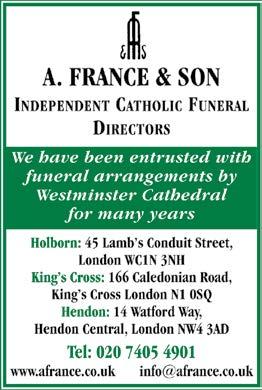Westminster Cathedral Magazine

If you can, please make a donation for your copy to cover its production cost. Thank you.


If you can, please make a donation for your copy to cover its production cost. Thank you.

Although we earn income from the advertising which we carry, Oremus relies on donations from readers to cover its production costs.
The Companions of Oremus was established to recognise those who give generously to support us. Open exclusively to individuals, Companions’ names are published in the magazine each month (see page 7). All members are invited to one or more social events during the year and Mass is offered for their intentions from time to time.
If you would like to support us by joining the Companions, please write to Oremus, Cathedral Clergy House, 42 Francis Street, London SW1P 1QW or email oremuscomps@rcdow.org.uk with your contact details, including postcode. Members are asked to give a minimum of £100 annually. Please mention how you would like your name to appear in our membership list and if you are eligible to Gift Aid your donation. Postal subscriptions to Oremus may be purchased by completing and sending to the office the coupon printed in the magazine. Subscriptions to receive Oremus either by email (free) or as hard copy by post (p & p payable) can also be entered by visiting https://westminstercathedral.org.uk/the-cathedral-community/about-oremus/ and completing the form there.
Thank you for your support.
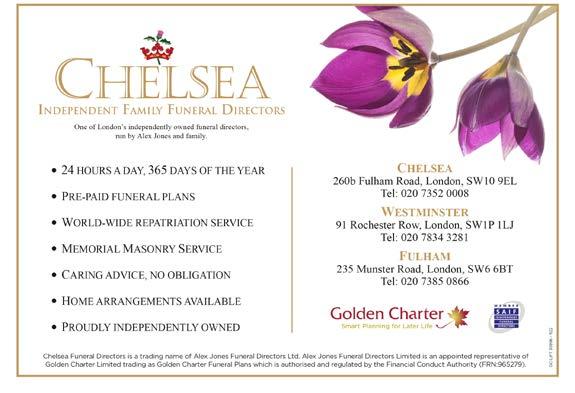
Cathedral Clergy House
42 Francis Street
London SW1P 1QW
T 020 7798 9055

E oremus@westminstercathedral.org.uk
W www.westminstercathedral.org.uk
Oremus, the magazine of Westminster Cathedral, reflects the life of the Cathedral and the lives of those who make it a place of faith in central London. If you think that you would like to contribute an article or an item of news, please contact the Editor.
Patron
The Cardinal Archbishop of Westminster
Chairman
Fr Sławomir Witon´
Editor
Lorcán Keller
Oremus Team
Tony Banks – Distribution
Marie Carne – Content Compilation
Ellen Gomes – Archives
Zoe Goodway – Marketing & Finance
Paul Moynihan – Proofreading
Manel Silva – Subscriptions
Design and Art Direction
Julian Game
Registered Charity Number 233699 ISSN 1366-7203
Opinions expressed by contributors do not necessarily represent the views of the Editor or the Oremus Team. Neither are they the official views of Westminster Cathedral. The Editor reserves the right to edit all contributions. Publication of advertisements does not imply any form of recommendation or endorsement. Unless otherwise stated, photographs are published under a creative commons or similar licence. Every effort is made to credit all images. No part of this publication may be reproduced without permission.

As any custodian of a historic building will attest, keeping water out is the number one priority. Westminster Cathedral is no exception, particularly given the vast Nave roof, the domes, and the multiple levels that need frequent maintenance. Pictured here, a surveyor from Heritage Stone Access Ltd. poses before scaling down the walls to inspect the slate tile roofs covering the side chapels etc. Thank you to Heritage Stone Access for providing this cover image and the photographs found in the Monthly Album, pp 20-21. Visit www.heritagestoneaccess.co.uk for more information on their work.
Cathedral Life
Homily: The Lord Mayor of Westminster’s Civic Service by Fr Christopher Colven 6 & 7
Cathedral History in Pictures: The Easter Vigil, 1957 by Paul Tobin 12
The Westminster Way 15
The Rite of Election by Ashley Avery-Bennett 16
Features
Siena Exhibition by Lucien de Guise 8 & 9
The Welsh Martyrs 10 & 11
One more step by Canon Chris Vipers 13 A Virtual Camino de Santiago 14 A busy few months by the Caritas Community Development team 17 & 18
Film Review: Conclave by Fr Hugh MacKenzie 22
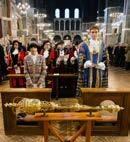
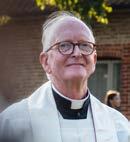

In Retrospect: 100 and 70 years ago 19
&
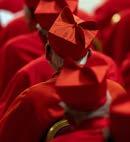


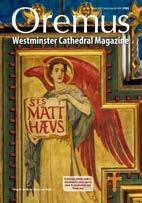

It never ceases to amaze me how a piece of music can transport you across space and time. Recently, while trawling through YouTube and old sheet music for a friend’s choir, I came across Jacobus Handl’s Ecce quomodo moritur (‘Behold how the righteous man dies’), a Maynooth Holy Week staple. Upon hearing this devastating Tenebræ responsory, I was immediately back in my choir stall, bleary-eyed and hoarse from weeks of practicing, and a relentless schedule. Although falsetto was frowned upon in the first tenor line, it was often necessary for such occasions, meaning that, by the Easter Vigil, we sounded like croaky adolescent boys.
This concept of ‘active’ memory, or anamnesis, is a fundamental tenet in Judaism and Christianity. When celebrating the Passover Seder, Jewish people are not reminiscing about the Exodus, they are actively taking part in their freedom from slavery. Likewise, Christ is not re-sacrificed at every Mass. Instead, we enter into that moment in history which would change everything, in the Upper Room and beneath the cross on Calvary.
In addition to the Jubilee, this year seems to be one long series of anniversaries. 2025 marks 1,700 years since the First Council of Nicaea, the first Ecumenical Council, held between May and July 325. Other than the Nicene (NicenoConstantinopolitan) Creed, it is perhaps best known for the legendary tale of St Nicholas punching the heretic Arius.
This September, the Diocese of Westminster will celebrate 175 years, having been newly created by Pope Blessed Pius IX on 29 September 1850, along with 12 suffragan sees. The foundation stone of Westminster Cathedral was laid 130 years ago on the Feast of Ss Peter and Paul, 29 June 1895, completed in 1903 and consecrated in July 1910, 115 years ago. Finally, on Thursday 8 May, the nation will celebrate 80 years of Victory in Europe, following the end of the Second World War.
Looking to the month ahead, On 1 April, Fr Chris Vipers will be installed as a Canon of the Chapter. The Choir continue on their tour of the United States, returning on 7 April, in time for Palm Sunday. The following day, the King and Queen will have an audience with Pope Francis, presumably in the Gemelli Hospital where he has been receiving treatment since 14 February. Later this month, if he is well enough to do so, the Pope will canonise Carlo Acutis, grandson of our former parishioners, on Divine Mercy (Low) Sunday, 27 April. We continue to keep the Holy Father in our prayers.
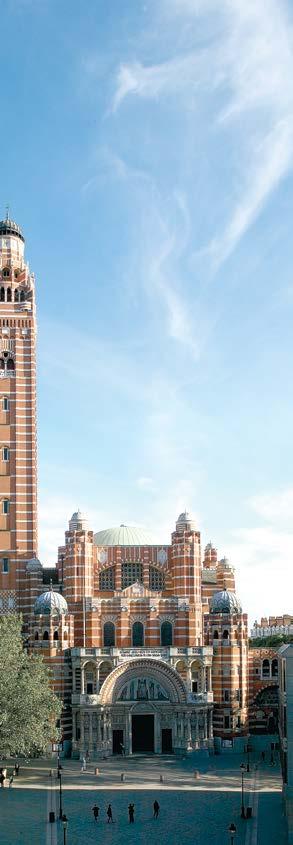
Westminster Cathedral
Cathedral Clergy House
42 Francis Street
London SW1P 1QW
Telephone 020 7798 9055
Email chreception@rcdow.org.uk www.westminstercathedral.org.uk
Cathedral Chaplains
Fr Sławomir Witoń, Dean
Fr Brian O’Mahony, Sub-Dean
Fr Patrick van der Vorst, Precentor
Fr John Scott, Registrar
Fr Vincent Mbu’i SVD
Fr Paul Zhao SVD
Fr Hugh MacKenzie
Fr Javier Ruiz-Ortiz (priest in residence)
Also in residence
Franciscan Sisters of Our Lady of Victories: Sr Jesuina, Sr Angelina and Sr Fatima
Music Department
Simon Johnson, Master of Music
Peter Stevens Obl. OSB, Assistant Master of Music
Daniel Greenway, Organ Scholar
Cathedral Manager
Peter McNulty
Chapel of Ease
Sacred Heart Church
Horseferry Road SW1P 2EF
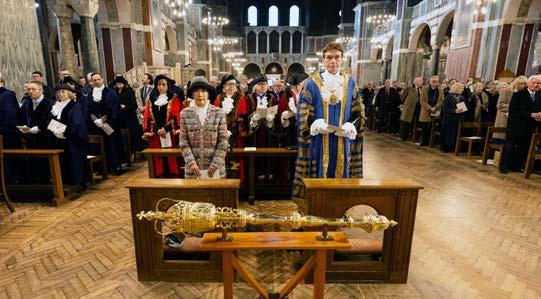
On the journey towards Easter, we have reached the Second Sunday in Lent. In a month’s time we shall move into Holy Week and during the Maundy Thursday Mass, as he does each year, the Cardinal will wash the feet of 12 Chelsea Pensioners – a reminder of what Jesus did for his first disciples at the Last Supper. By tradition, during the feetwashing a response is sung: ‘Ubi caritas et amor, Deus ibi est’ (‘Wherever charity and love are to be found, God is there’).
The passage of Scripture which the Lord Mayor has just read is attributed to St John. John was, supposedly, the youngest of Jesus’s first chosen disciples and, as such, the one closest to his heart; the only one not to suffer a martyr’s
death. John is the great Apostle of Love, and it is from his Gospel and his Letters that we gain unique insight, as we try to answer the age-old questions: ‘Who is God?’ and ‘What is God really like?’
For St John, three short words tell us everything we need to know, and indeed everything we can ever know: ‘God is love’. The first two words stand on their own. They tell us not just that there is a God, that he exists, but that he ‘is’; not that he stands as an onlooker, but that he is ever-active within the created order of which he is the source and origin. The God-who-is, for John, is revealed uniquely in the Person of Jesus whom another John, this time the mystic John of the Cross, describes simply as ‘the All of God’.
The third word which completes the definition of God is ‘love’, and ‘love’ for the scriptures is essentially about action not feeling, conduct rather than emotion. ‘In this is love, not that we have loved God but that he loved us.’ The Christian understanding is that, in some way which goes way beyond our comprehension, the God who is love, shares that love, which is the essence of his own being, with those he has made in his image and likeness. We are capable of loving because we are inspired, quite literally, by Divine Love. In a sense, we love, in our turn, with a love which overflows from the heart of God ‘Ubi caritas et amor, Deus ibi est’, ‘Wherever charity and love are to be found, God is there’.
We have come together this afternoon to share in a Civic Service. Our prayers are specifically offered for those who serve in the governance of this great City of Westminster, and we do so with gratitude for all the time and commitment that the few give to provide for the needs of civil society. There is much cynicism about those who serve in public office today. It is unfair and misplaced.
Pope Francis’s predecessor, Benedict XVI, began his own Pontificate by writing an encyclical letter based on the passage from St John which we heard earlier. After reflecting on the theology of love, the late Pope moved on from theory to practice and he devoted several paragraphs to those who work for the common good in civil society, and the need for collaboration with the faith communities.
‘Love’, he wrote, ‘caritas’, will always be necessary, even in the most just society. There is no civil order, however just, that makes the service of love superfluous. There will always be suffering that needs comfort and help. There will always be loneliness. There will always be situations of material need in which help that shows concrete love
for one’s neighbour is indispensable. A society that wants to provide for everything, that absorbs everything into itself, ultimately becomes a bureaucratic body that cannot ensure the most essential thing any human being needs; a deep personal attention. What is needed is not a governance that regulates everything, but one that generously recognises and supports the initiatives that arise from the various social forces and that unite spontaneity with closeness to people in need. The letter goes on to identify the Church as:
‘one of these living forces. In her beats the dynamism of love, inspired by the Spirit of Christ. This love does not only give material help but also peace and care for the soul, a help often more necessary than material sustenance.’
The Catholic Church as with the other faith communities, sees itself as a community of love existing for the service of love. Our ever-expanding corpus of social teaching, with its threefold cornerstone based on human dignity, solidarity, and subsidiarity has been further enhanced by Pope Francis’s emphasis on the need for mercy in our relations with one another, both individual and corporate. There is a
We are very grateful for the support of the following:
Leticia Dominguez Abada
Lally Ambatali
Keith Best
Dr Stuart Blackie
Anne Veronica Bond
Lolita Botanes
Richard Bremer
Lorenzo Cabrelli
Ms Virginia Pinto Cassama
Mrs Erlinda Chin
Francis George Clark
R & L Collyer-Hamlin
Daniel Crowley
Angelita Caronan Duran
Cora Emflorgo
Ms Georgina Enang
Fr Joseph Farrell K.H.S.
Ruby & Joseph Farrell in memoriam
Fred Gardiner
William Gardner-Hunter
Connie Gibbes
Zoe & Nick Goodway
Rosalinda Grimaldo
Agnes Haein Kim
Mrs Valerie Hamblen in memoriam
Amanda Hill
Jithro and Ira Nadine Hangad
Bernadette Hau
Mrs Cliona Howell
Alice M Jones & Jacob F Jones
Poppy K
Rosanne Kay
Mary Thérèse Kelly
John Langan
David Lawton
Raymund Livesey
Alan Lloyd in memoriam
Clare and John Lusby
Linda McHugh
Christiana Thérèse Macarthy-Woods
Ms Ludivina Mangmang
James Maple
Paul Marsden
Mary Maxwell
Dr Denis Moloney
Dr George Morris
Abundia Toledo Munar
Euphrasie Mundele Kilolo
richness here which is open to be shared more widely. In the complexities of a modern city, like Westminster, with all its demands and challenges, Catholics alongside other believers join in wanting to make their contribution to building a just and compassionate environment. One in which all may flourish, and where those on the margins find their rightful place within civil society.
On Maundy Thursday, as Cardinal Nichols washes the feet of the 12 Chelsea Pensioners, he will symbolise, he will sacramentalise, the conviction that our only response to the God who is the source of all that is loving, must be to wash the feet of our brothers and sisters, metaphorically, if not literally. The same St John who gives us the definition of God’s essential nature can also say:
‘Those who do not love the brother or sister they can see, cannot love the God they have never seen. So this is the commandment that he has given us, that anyone who loves God must also love his brothers and sisters.’
‘Ubi caritas et amor, Deus ibi est.’ ‘Wherever charity and love are to be found, God is there’.
Chris Stewart Munro
Mrs Brigid Murphy
Kate Nealon
Cordelia Onodu
Nigel Parker
Cris Ragonton
Alan Rainer
Clementina Rokosu
Precy Salvador
John Scanlan
Veronica Scrope
Sonja Soper
Tessa and Ben Strickland
Yollie Sumayod
Julia Sutherland
Eileen Terry
Robin Michael Tinsley
Lucila Torrefiel
Peter W Wilson
and of our anonymous Companions
If you would like to become a Companion of Oremus, see page 2
Lucien de Guise
The exhibition at the National Gallery opened on Ash Wednesday and closes on 22 June.
After a visit to the National Gallery, there can be no complaints about the sheer quantity of Christian art on permanent display here in London. Additionally, this spring, we have ‘Siena: The Rise of Painting, 1300-1350’; a fiesta of devotional works, following the definitive exhibition on St Francis of Assisi in 2023.
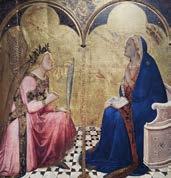
There are two National Gallery directors to thank especially for the rich repository of devotional art here in the capital, both of whom are, or were, Catholic. Sir Kenneth Clarke was the communicative aesthete who ensured they were protected during the Second World War. He was, perhaps, so inspired by the collection that he was received into the Catholic Church before his death. For the more-recent exhibitions, we have to thank Sir Gabriele Finaldi, a lifelong Catholic and member of the Westminster Cathedral Art and Architecture Committee.
Without wishing to malign the Protestant corpus, the debt that world civilisation owes to Catholic artists is incontestable. What is less well known is the contribution of one smallish city in Italy that has always been in the shadow of its grander neighbour. Florence is still
the superior self-publicist, while Siena’s flame shone brightly for a very short time and was then generally forgotten; until this exhibition came along.
In a spirit of fairness, the curators mention Florence quite often, while keeping their focus on the overlooked underdog. It’s astonishing how much of a combined legacy the two cities have left. We should be grateful that they have highlighted Siena, as that bright light needs to be rekindled occasionally. There is no danger here of the same Florence fatigue that was a hazard at the Victoria and Albert Museum’s Donatello exhibition two years ago. Keeping different traditions alive is essential and can be quite a revelation. Until the Royal Academy’s look at ‘Art and the Hispanic World’, also in 2023, who would have known what we owe to the often-anonymous artists of Latin America?
The Siena exhibition is a rare coming together of the artists who worked there, of whom Duccio and Simone Martini are pre-eminent. Siena, circa 1300, seems to have been a real cauldron of creativity. There’s drama, emotion, and bodies that appear more real than ever before. Most of the works are small and deserve the sort of intimate examination that might be given to an Eastern Orthodox icon. Many of them have not lost that icon-like appearance, although others are on a much larger scale. Also, for the first time, all the different components of Duccio’s majestic ‘Maestà’ have been brought together, thanks to the superior collaboration of New York’s Metropolitan Museum of Art and the National Gallery.
Seven centuries ago, Sienese painters collaborated with each other, too. They even worked with artists in other media, such as sculpture and jewellery. There is no sign here of the squabbles between prima donna-esque male painters found in Florence and Rome. Nor did I notice any female painters. However, a number of years ago the National Gallery did highlight
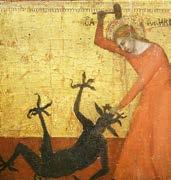
the life and work of Artemisia Gentileschi, a thoroughly abused heroine of the Renaissance, in an excellent solo exhibition.
Creativity and prosperity worked well together in Siena. The city was getting rich with banking and trade, buoyed by a stable government. Indeed, the many mentions of the Silk Road are a sure sign of the effective globalism found in a world with few national boundaries, and much curiosity about other cultures. As such, there seems to have been a healthy appetite for personal luxury, as many of these works were intended for private homes.
There is enough gloom, accompanied by focused lighting, to put visitors in a contemplative frame of mind. Those seeking education rather than inspiration will find expansive labels in addition to the numerous panels. Some of the insights are revealing on practical grounds, acting as a reminder of how war can intervene in an otherwise straightforward story of art. For example, all that remains of an almost-lifesize crucifix carved by Lando di Pietro, is the head of Christ. It is now in two halves, after a bombing raid during the Second World War. The benefit of this damage is that a piece of parchment found inside reveals the words of the artist:
‘The Lord God made it possible for Lando di Pietro of Siena to sculpt this cross from this wood in the likeness of the true Jesus Christ […] and one must worship him and not this wood.’
Amid his prayers for safety, and protection from God’s enemies, he was apparently concerned about the possibility of idolatry, which was a heated debate at the time.
There are other works of art in the round — always considered by iconoclasts to be the most susceptible to worship as idols — but most of the exhibition is in two dimensions. Every painting has religious significance. Whether it’s the Crucifixion, the Madonna and Child or any of the many saints; 14th-century Siena was a world in which faith directed art. These are serious expressions of belief, often shown in surprising ways. Among the most striking is a small detail in a painting by the Circle of Simone Martini, of a panel depicting St Catherine. Surprisingly, it depicts St Catherine of Alexandria, not Siena. In the lower left corner there is the powerful figure of St Margaret of Antioch. Not one to take Satan’s presence lightly, after she had been swallowed whole by him, the saint is seen striking the horned-one vigorously with a hammer.
At this time, it was still common to have sideshows to the main activity of a painting. There are many other details to beguile the viewer, just as they would have done seven centuries ago. Rarely do we know the names of the patrons. Ambrogio Lorenzetti’s commission for Siena’s tax office is, therefore, a surprise. It is also remarkable for the size of the figures within the composition, and the way that the words spoken by the Virgin Mary and Gabriel have been incised into the surface.
Depicting precious materials such as gold and silk textiles was an important part of the paintings. It’s a direction that the exhibition explores with conviction.
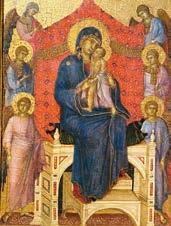
Alongside some of the Sienese works are the decorative arts that inspire their lavishness. There are many textiles. Some of these are labelled ‘Mongol’, which is absolutely true, but doesn’t tell the whole story. The Mongols by this stage had settled down in various parts of Asia and the dynasties that traded most with Europe had become Muslim. Perhaps an exhibition on the ‘Pax Mongolica’, which opened up the whole continent of Eurasia to trade in wondrous materials, would be of benefit. For now, it’s enough that the National Gallery shows some of these fine fabrics that so impressed the Sienese.
The free movement of pilgrims was also a major factor in Siena’s rise to greatness. Travelling from France to Rome, Christians brought their wares and ideas along the well-trodden path. Another bonus of the exhibition is the quantity of liturgical items on display, some were made in Siena, and others imported. Almost all display the crosscurrents of influence that pilgrimages brought. One example, from the Louvre Museum, is the crucifix attributed to Tondino di Guerrino, circa 1325-30.
He was one of Siena’s most renowned goldsmiths, and this example appears to have been both an altar and a processional cross. Its gilded silver corpus is as moving as anything in the exhibition, particularly when accompanied by the gorgeous enamelling, which was reworked in France more than a century ago.
Visiting the exhibition is like a world tour of famous collections. It is also the only opportunity that visitors to the National Gallery are going to have for viewing some of the Gallery’s most important treasures. Top of the list is the finest English religious painting to have survived the Reformation. The Wilton Diptych occupies a space near the exit and is almost overwhelmed by its Continental cousins. Commissioned by King Richard II, it is another example of a devotional work for private worship. Rather than being intended for a church, it was probably kept in the Palace of Westminster, at the opposite end of Victoria Street.
Another link is the presence of King Edward Confessor in both the diptych and the Cathedral tympanum that faces Victoria Street. Although not many viewers notice this rare saintly king in either painted or mosaic form, he can be identified by the ring that he holds. This had been brought from the Holy Land and had miraculous properties. This is one of the few details not provided in a very informative and comprehensive exhibition.
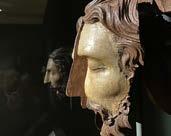
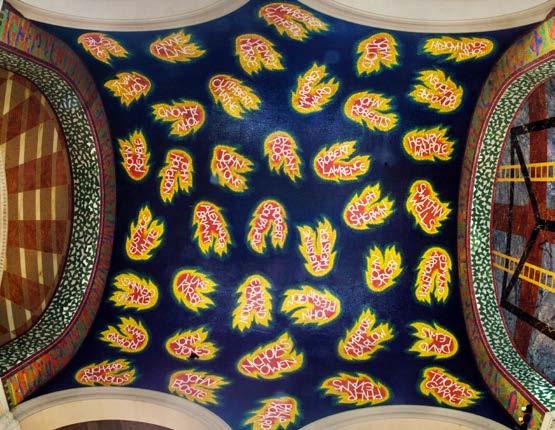
St John Roberts 1577-1610
John Roberts, a Benedictine, was born at Rhiw Goch, Trawsfynydd in 1577, the eldest son of Robert and Anna Roberts having two brothers and three sisters. Although raised Protestant, it is believed that he received his early education from a dispossessed monk from Cymer Abbey, following the dissolution of the monasteries. He joined St John’s College, Oxford on 26 February 1596, where he came into contact with
William Laud, who would later become Archbishop of Canterbury. He left Oxford to study law at Furnival’s Inn, London.
He travelled to Paris in 1598 and whilst there he became a Catholic at Notre Dame Cathedral. He visited the Jesuit College at Bordeaux, before joining the Society at the English College in Valladolid, in October. In 1599 he went to St Benedict’s Abbey, Valladolid, where he became a Benedictine and
spent his novitiate in the Abbey of St Martin in Santiago de Compostela, towards the end of 1600. He adopted the name of Fray Juan de Mervinia, ‘Brother John of Merioneth’. This suggests that his old country was very dear to him and that he had a high regard for Wales. He was ordained and set forth on the English Mission on 26 December 1602 being the first monk to return to England following the closure of the monasteries. The symbolism of
the Benedictine St Augustine’s Mission to the Angles was not lost on his contemporaries. As A Dom Weldon wrote:
‘He was the first who, out of a monastery, after the suppression of monasteries in England, attacked the gate of hell, and provoked the prince of darkness, in his usurped Kingdom, which he overcame, like his great Master, the Prince of martyrs, by losing his life in the conflict.’
Lewis Owen (Y Llwyn, Dolgellau) the spy said:
‘He was the first that had his Mission from the Pope and his own Spanish prelate to go to England, which made him not a little proud that he should be a second monk, to convert and reconcile his countrymen to the Roman Anti-Christ.’
Despite being followed by spies, Fr John landed in England in April 1603. He made quite a name for himself attending to the sick and dying during the plague, being noted for his constancy, zeal, charity and persevering devotion. He fell into the hands of the authorities four or five times, once in November 1605, during the Gunpowder Plot. However, on each occasion, after a short term in prison he was sentenced to be exiled.
Despite knowing that he faced execution, he returned to England for the last time in 1610. Whilst finishing
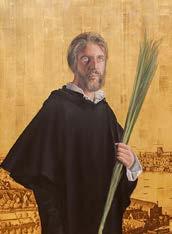
Mass he was arrested and taken in his vestments to Newgate. Being found guilty of high treason, Fr John was hanged, drawn and quartered at Tyburn on 10 December 1610. Although it was custom to disembowel the victim before death, the crowd would not allow it, owing to his kindness and care for them during the plague. Likewise, the heart would be shown to the crowd, crying, ‘Behold the heart of a traitor!’ to which the crowd would respond ‘Long live the King!’ On this occasion, the crowd was silent. St John Roberts was executed with another priest, Blessed Thomas Somers, and 16 felons. Much like his Master, he was executed aged 33 among thieves.
His fellow monks took his remains to Douai in France, after a daring mission to rescue them two days after the martyrdom, buried under the 16 felons. Unfortunately, most of his relics went missing during the French Revolution. However, there is one finger at the Catholic Church in Blaenau Ffestiniog, one in Tyburn Convent, and another in Taunton Convent.
St Philip Evans 1645-1679
Philip Evans, a Jesuit, was born in Monmouth in 1645, the son of Winifred Morgan of Llanvihangel Crucorney and William Morgan of Llangattock-VibonAvel.
Educated at the English College at St Omer in Flanders, he entered the Society of Jesus in September 1665, was ordained at Liege in 1675 and then missioned to south Wales where he served four years before being arrested. He was known for his zeal and charity and was fearless in caring for the Catholics entrusted to him. Fr Evans regularly stayed at the home of Thomas Gunter of Cross Street in Abergavenny and celebrated Mass there. The Catholic Church in Abergavenny has in its possession a small travelling chalice thought to have been owned by Fr Evans.
He refused to leave Wales when the persecution of Catholics increased, following the Titus Oates plot of September 1678, which falsely accused Jesuits of planning to assassinate King Charles II. The government normally offered a reward of £50 for the arrest of a Jesuit, but the local Welsh magistrate, who was a staunch Calvinist, offered
an additional £200 for the arrest of Fr Evans. Despite this, Fr Evans continued serving as the chaplain of Christopher Turbeville in Glamorgan. On 4 December 1678, Fr Evans was arrested at Sker House, having been betrayed by Edward Turbeville, younger brother of Christopher and a lapsed Catholic. He was imprisoned in Cardiff Castle Gaol and kept in solitary confinement in the dungeon. After several weeks, he and a fellow Welsh Jesuit, Fr John Lloyd, who had been arrested in November, were permitted to share a cell.
Having been in the dungeon for five months, Fr Evans eventually went on trial on 3 May 1679. The chief witness against him was an apostate named Mayne Trott who was in the service of John Arnold of Abergavenny, an indefatigable priest-hunter, who had offered £200 for Fr Evans’s arrest. The prosecution had great difficulty in finding witnesses to testify that he was indeed a priest. Eventually, a mother and daughter said they had received the Sacraments from him. Fr Evans was found guilty of the treasonable offence of being a Catholic priest and sentenced to death. The execution was delayed for some time and Fr Evans was allowed out of prison for recreation. On 21 July 1679, orders were sent out that his execution was to take place the following day. The gaoler found Fr Evans playing tennis! When he had finished his game he wrote a letter to his sister, Sr Barbara Catherine, a Blue Nun in Paris, telling her of his approaching death and insisting that she should not mourn him but be joyful. The following morning when officials came to lead him to his execution, they found him joyfully playing his harp.
Frs Evans and Lloyd were then taken to the place of execution at Gallows Field, Pwllhalog, Cardiff where they were both hanged, drawn and quartered. St Philip died first, after having addressed the people in Welsh and English, and saying; ‘Adieu, Mr Lloyd, though for a little time, for we shall shortly meet again.’ On mounting the scaffold, Fr Evans said;
‘ This is the best pulpit a man can have to preach in, therefore, I cannot forbear to tell you again that I die for God and for Religion’s sake.’
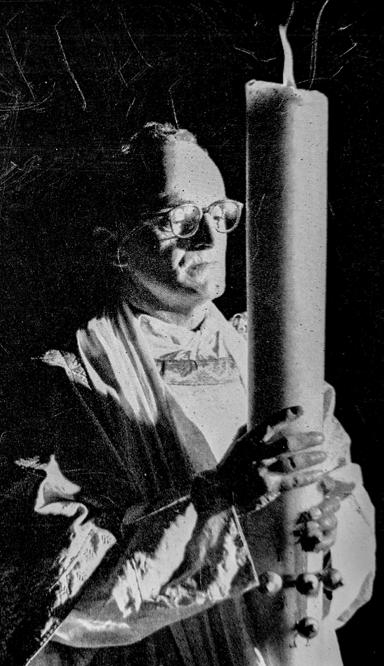
Paul Tobin
In 1951, Pope Pius XII granted permission for all cathedral churches to celebrate the Easter Vigil on Holy Saturday night. This was done on an experimental basis, restoring the Easter Vigil from a morning Mass to a night vigil, with the expectation that the first Mass would begin around midnight.
The rite of the Easter Vigil was also simplified, allowing for the new fire and Paschal Candle to be blessed in the narthex, and thus witnessed by the congregation. The lit Paschal Candle was then carried in procession by a deacon. Previously, he carried a reed with three candles to the sanctuary, where he lit and blessed the candle whilst singing the Exultet (Easter Proclamation). While most of the traditional ceremonies were retained, the twelve prophesies were reduced to four. The Renewal of Baptismal Promises by the faithful was then added, demonstrating the wish of Rome to see more congregational participation in the liturgy.
The first Easter Vigil in the Holy Night was celebrated in Westminster Cathedral in 1955, one year before it became mandatory. The liturgy began at 8pm, to allow time for those needing public transport afterwards to get home safely. In 1956, the newly revised Holy Week ceremonies became standard, and the Easter Vigil was moved to 7pm, later moving to 10.30pm with a Mass at midnight. Since the last major revision to the Holy Week ceremonies in 1970, the Easter Vigil in Westminster Cathedral has consistently been at 8.30pm.
As many parishes now have permanent deacons, the Easter Proclamation is commonly sung by a deacon, as was the custom. Previously, in the absence of a deacon, a priest would don a white dalmatic as can be seen in the photograph of Fr Michael Ware carrying the Paschal Candle in procession in 1957.
Sources:
The Tablet: 16/4/55, 18/2/56
Adrian Fortescue, ‘The Rites of Holy Week’, The Holy Week Book (1916). Reprinted in Holy Week 1951, Burns, Oates & Washbourne Ltd.
Fr Chris Vipers will be installed as a Canon of the Westminster Cathedral Chapter at Vespers on Tuesday 1 April, 4.45pm.
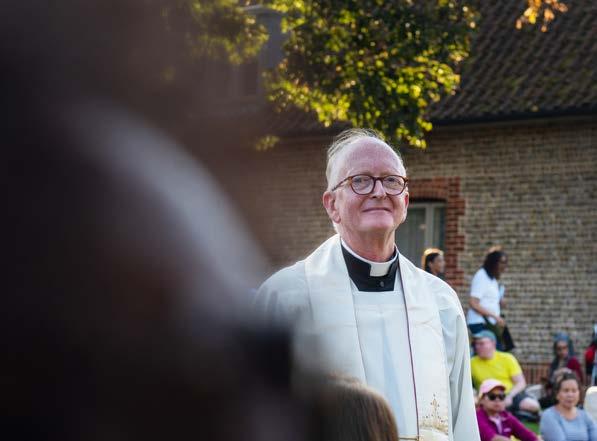
At the recent Rite of Election in Westminster Cathedral, on a gloriously sunny afternoon in early March, the memories of my own journey came flooding back. On 25 May 1996, the Vigil of Pentecost, I was received into the Church and confirmed at The Most Precious Blood and St Edmund, Edmonton.
Previously, I had served in Anglican Ministry since my Ordination at St Paul’s Cathedral in 1989; first as Curate and then as Vicar in the Wood Green Team Ministry. Those short, but beautiful years opened my eyes to the joys and sorrows, the struggles and yearnings, and above all the amazing gifts of the parishioners I was called to serve. I owe nothing but gratitude to the Church of England, which nurtured my faith from the start. It was there that I first heard the gracious calling of the Lord to give my life in service, and where I first fell in love with him.
I was later ordained a deacon by Bishop (now Cardinal) Vincent Nichols,
and a priest by Cardinal Basil Hume in 1997. The years that have followed have challenged and rewarded me in equal measure. I have worn many hats as Hospital Chaplain in North London, SPEC Chaplain at our old Pastoral Centre, Vocations Director, Pilgrimage Director, National Chaplain of the Catholic Stage Guild, Dean, Episcopal Vicar, Director of the Agency for Evangelisation, Assistant Priest in Edmonton and Commercial Road, and Parish Priest in Covent Garden, Feltham and now Moorfields and Bunhill Row.
Many of these appointments have scared and surprised me, but each have proved that ‘yes’ is always the right answer. They are ministries that I would never in a million years have volunteered myself for, but each one has given me so much. They have helped to make me as a man, as a disciple, and as a priest.
Each year at the Chrism Mass in the Cathedral, as the Holy Oils are blessed for use throughout the year, and priestly
commitments are renewed, my mind always wanders. I try to bring as many faces to mind of those I have tried to love and serve over the years, of those who have loved me and formed me as a priest from as far back as I can remember. I say a lot of ‘thankyou’s’ during that celebration, and then I bring them all to the Mass of the Lord’s Supper on Holy Thursday night. In doing so, I try to imagine all of the feet throughout my ministry that I have tried to wash, and those who have bathed me in their love and their prayer.
As the adventure of my life, and the adventure of my priesthood continue, I pray that many more young men will also hear and respond to the Lord’s call in their life. If he is truly calling them, then they will never be really happy, at peace deep-down, or fully alive, until they say that simple but enormous threeletter word – ‘yes’. Please join me in praying that God will send more priests into the harvest of our big and beautiful Diocese.


On Sunday 2 March, Rob Wizik set out to walk the 26-mile route from Brentwood Cathedral to Westminster Cathedral, following the Elizabeth Line, with friends Dan and Tony. At 7.38am, they were blessed and sent off by Fr John Harvey and CAFOD Community Coordinator Chris Driscoll, visiting various churches, and picking up a few friends along the way. These pilgrims of hope arrived at the Cathedral at 6.30pm, in good time for the evening Mass.
This pilgrimage formed a small part of Rob’s virtual Camino de Santiago, a personal commitment to walk 744 km from 14 January to Holy Saturday night, when he will receive the Sacrament of Confirmation. Indeed, he plans to save the final 10 meters for his pilgrimage down the aisle of Brentwood Cathedral at the Easter Vigil.
‘ The walk has been both rewarding and challenging, but the encouragement from parishes, fellow Catholics, and supporters has been
incredible. It’s been a way to reflect on faith, sacrifice, and service while also making a tangible difference.’
This deeply personal and spiritual journey has been undertaken in aid of CAFOD, raising funds for their work supporting communities worldwide.
‘ Taking on this challenge while preparing for my confirmation felt like the right thing to do. It’s a way to test my faith and put it into action. Fundraising for CAFOD allows me to support communities affected by conflict and poverty. I want to make a difference and hope to raise at least £1,000.’
To support Rob, scan the QR code:

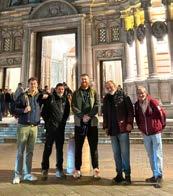
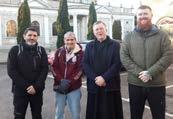
‘A pilgrimage on foot is a great aid for rediscovering the value of silence, effort and simplicity of life. In the coming year, pilgrims of hope will surely travel the ancient and more modern routes in order to experience the Jubilee to the full.’
To celebrate the Jubilee Year, the Diocese of Westminster has created a seven-mile pilgrim route in the steps of saints and martyrs, our ‘Beacons of Hope’, beginning at Tower Hill and ending at Westminster Cathedral.
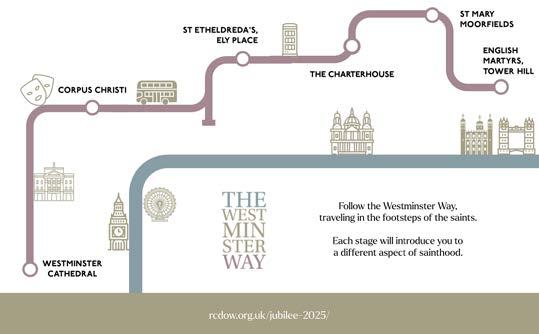
To download a leader’s guide and a pilgrim passport, visit: rcdow.org.uk/jubilee-2025/westminster-way
Ashley Avery-Bennett
On Saturday 8 March, I found myself standing in the shadow of Westminster Cathedral, about to take my first official step of initiation into the Catholic Church at the Rite of Election. Now, for someone who has twice thrown his hat into the political ring only to have it handed back to him by the electorate with a polite, but firm ‘no thanks’, the prospect of finally being part of the ‘elect’ was, to put it mildly, rather novel and exciting. It was the symbolic final bell lap of my marathon towards Baptism; a truly special and important moment.
However, as I stood there in the heart of London, basking in a burst of March sunshine, something else rather extraordinary began to dawn on me. There were hundreds of us — more than 500! This was, I later discovered, the largest number of catechumens and candidates since 2018. And yet, it was not the sheer magnitude of the crowd that set my cerebral cogs a-whirring, but rather its composition. A striking proportion of those assembled were positively fresh-faced, unblemished by the relentless march of time, untouched by the creases and crinkles that life so gleefully bestows. In short, they were young!
I was later to discover, over a convivial, if not entirely Lentenappropriate, pint of post-Rite beer, that I was by no means alone in having my curiosity piqued by this remarkable demographic quirk. It seemed obvious to everyone. I had first noticed this phenomenon at my parish RCIA (Rite of Christian Initiation for Adults) course. At 28, I’m no spring chicken. I am still young enough to avoid lower back pain, but old enough to wince when offered a shot of tequila. Still, I had wrongly assumed I would be the baby of the group whereas, in reality, some of my fellow candidates and catechumens were as young as 16 or 17!
Now, one can easily comprehend why someone of my own vintage, teetering on the precipice of their third decade, occasionally roused from slumber in a cold sweat at how quickly time has passed, might find themselves drawn towards the solace and certainty of religious faith. But these bright-eyed sixth formers are not yet adults; they are still ensnared in the clutches of peer pressure and the burning desire to blend in. For them to make, of their own volition, the resolute and counter-cultural choice to join the Catholic Church is nothing short of astonishing. The Rite of Election proved emphatically, and most encouragingly, that this was far from just a local quirk. However, should I really have been so surprised?
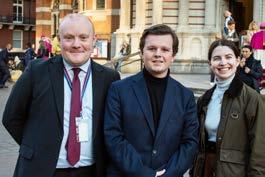
Earlier this year, The Times published a fascinating survey on the shifting social attitudes of Generation Z; those born after 1997, weaned on iPhones, TikTok, and a diet of frenetic digital chaos. The results were eyebrow-raising, to say the least. This generation, far from embracing the Dawkins-esque atheism as so confidently predicted, is actually more likely to believe in God than their parents or grandparents. They are also far more likely to describe themselves as ‘spiritual’. These are young people who have never known a world without social media, without dopamine hits from Instagram likes, without the endless scroll of instant gratification and empty fame. Is it really so inconceivable that they might, just might, be searching for something more profound? Something older, richer, and, dare I say, transcendent? Indeed, where better to find this than in a Church that has spent the better part of 2,000 years declaring, without apology or dilution, that there is indeed meaning in the universe?
You might say that, in a world of disposable culture and algorithm-driven banality, the Catholic Church stands as an immovable rock of eternal wisdom. It doesn’t pander. It doesn’t sway in the wind. It simply is. In a world that feels increasingly like a madhouse with no off switch, that solid, immovable certainty is, quite frankly, irresistible. It was for me, at least.
To borrow a rather hackneyed phrase, there is most certainty ‘something in the water’. Many people, myself included, are grappling with the great, gnawing questions of life, and finding — almost unexpectedly — that the answers lie within the embrace of faith. Just days before the Rite of Election, I attended Ash Wednesday Mass at the Cathedral. Now, bear in mind that there was no ‘obligation’ to attend, and yet the place was heaving. Standing room only. I am told that similar scenes have also been witnessed in churches across the globe. Is this all just a blip? A curious anomaly? Perhaps, but my gut tells me otherwise. Something is stirring. Something profound. A yearning for meaning in an age of meaninglessness and, my goodness, is it glorious to witness and to be a part of.
So, as I prepare for my own Baptism at the Easter Vigil, I do so with a buoyant optimism. Far from entering a Church in its twilight, I am joining a Church that is erring on the brink of a youthful renaissance. Call it the stirrings of Divine Providence, call it youthful rebellion against a vacuous culture; whatever it is, it is happening.
The timeless words of St Augustine, ‘ever ancient, ever new’, feel as profoundly true today as they ever did. A fitting epitaph for a Church that, against a cultural tide, continues to renew itself with unwavering vitality.
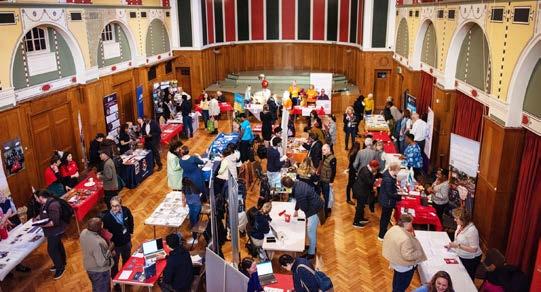
The Caritas Community Development team works closely with parishes and schools in the Diocese of Westminster, to support them in setting up or developing social action initiatives. The Food Programme and Caritas Volunteer Service provide support across the Diocese, whilst our Development Workers focus on parishes, schools, projects and partners in their designated episcopal areas, as well as leading on certain areas of Caritas Westminster’s work. When not busy with emails, phone calls or preparing resources, you’ll find us out and about around the Diocese; whether that’s meeting parish priests and key partners, visiting schools and social action projects, or attending deanery meetings.
At the end of January, Iman, our Food Programme Support Officer, joined volunteers from Neighbours in Poplar for one of their regular visits to Calais. She returned to Poplar with Stephen Curran, our Head of Community Development, where they represented Caritas Westminster at a ‘Justice, Peace and Hope Day’ hosted by the parish. The event featured stalls and presentations from participating charities, who shared stories and experiences relating to the day’s theme before a closing Mass for Peace and a meal. Closer to home, Iman then visited the Cardinal Hume Centre, to which staff at our Diocesan HQ in Victoria have donated items as part of our annual Caritas Advent Giving Calendar initiative.
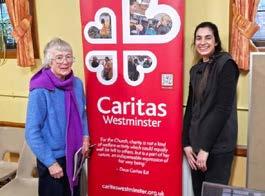
Elsewhere, Rocio, our Development Worker for North London, accompanied our Food Programme Lead Niki on a visit to the Social Apostolate at St Ignatius parish in Stamford Hill. The project provides hot meals, food bags, clothes and other essential support to over 70 people who are homeless or in need. Rocio and Niki took the opportunity to help with serving meals, while finding out more about the project’s work and the people it serves.
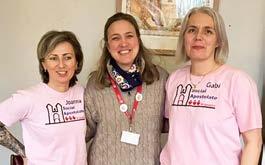
Two members of our team have been keeping busy in schools. Fran Moore, our Development Worker for South Hertfordshire, spent three days at St Joan of Arc Secondary in Rickmansworth, where students were learning about Modern Slavery in the week leading to the feast of St Josephine Bakhita. Assisted by Stephen, and in collaboration with the charity A21, Fran led two assemblies and six workshops on the themes of Catholic Social Teaching.
Meanwhile, Sr Silvana Dallanegra has been out and about in the west of the Diocese. Along with her trusted assistant Nigel the Penguin, Sr Silvana delivered assemblies at St Swithun Wells Primary in South Ruislip and at St Joseph’s in Chelsea, where she


gave badges to their eleven Caritas Ambassadors and heard about their latest social action initiative. As always, Nigel was the star of the show!
In February, Elke and Juliet from the Caritas Volunteer Service spent much of the month preparing for our Jubilee Volunteering Fair on Saturday 8 March in Cathedral Hall. 21 charities attended, advertising a wide variety of roles both in parishes, across the Diocese and further afield. Elke and Juliet were delighted to be able to promote the event on air with Radio Maria England and talk about the many benefits of volunteering. The month then ended on a high for Liz Wills, our Development Worker for North Hertfordshire, and our friends at the Hitchin Pantry, when one of their volunteers received a North Herts Heroes award from the District Council.
One of our favourite aspects of being part of the Community Development team is our regular contact with hundreds of caring, committed volunteers across the Diocese, who go the extra mile in their generosity and service to parishes or social action projects. This includes our growing number of Caritas Parish Representatives, who act as the main social action link between their parish and us.

If you have a heart for social action and a few extra hours, perhaps this could be a role for you: why not contact your area’s Development Worker, or scan the QR code to find out more?

‘Sacred music must possess the qualities which belong to liturgical rites, holiness, beauty, and universality. It must be holy, and there avoid everything that is secular. It must be an art, since in no other way can it have on the mind of those who hear it that effect which the Church desires. It must also be universal, so that, although each country may use in its ecclesiastical music whatever special forms belong to its national style, these forms must be subject to the proper nature of sacred music.’
These principles have been laid down for our guidance by the Supreme Pontiff. In accordance with them our liturgical music is selected and naturally falls into three categories—Gregorian Chant, Classical Polyphony, and Modern Sacred Music.
The Holy Week list of music this year contains nothing original. Most of the music is sung only once in the year, and to seek for new material would be to sacrifice the old. Among the English composers pride of place has been given to Taverner (cir. 1495-1545), whose chief Masses will be heard during the week. The ‘Western Wynde’ has not been included for the simple reason that it has not been re-scored yet. In course of time we hope to produce more of Taverner’s work, including the fine motet ‘Mater Christi’. Taverner is but now coming into his own. He is an outstanding figure in pre-Elizabethan music, and his work needs no apology. His use of imitation—his use of ‘tone colour’ as exemplified in the contrast between voices—show him as the equal of Tye. Bold and vigorous is his writing, and, above all, original. It remains to add that music occupied only the first part of his life and that he died in 1545, when Byrd was just two years old. The other composers are too well-known to need further comment. Tallis and Byrd and Tye are all represented. R. Deering’s beautiful motet will be sung on Thursday morning. Of the modern composers three only are represented.
The Altar Society Annual Report, 1954
Secretary’s Report
The two most important items we have to record in 1954, are the completion of the Marian vestment in time for Corpus Christi, and of the white Pontifical High Mass set in time for Christmas. In each case, the gold embroidery from the old vestments has been transferred
on to new material, the embroidery being renewed where necessary. The Good Shepherd nuns at Windlesham, who embroidered the Marian set, and the Dominican Sisters at Carisbrooke, who undertook the Pontifical High Mass set, are to be congratulated on the very high standard and excellence of their work, which has resulted in two such magnificent sets of vestments. They have been greatly admired, and should give good service for many years to come. A set of white High Mass vestments for Sundays is nearly finished, and new frontals for the Blessed Sacrament Chapel, with tabernacle curtains to match, are being made in red, green and purple, and will be ready early in the New Year.
Preliminary work has started on an embroidered white antependium for the Blessed Sacrament Chapel, which is to be the gift of the Cathedral C.T.S. Bookcase Committee, and we are indeed grateful for the generous assistance which has been promised to us for this purpose. To help in the embroidery of this frontal, Mrs Ashdowne has given a magnificent present of Japanese gold thread, for which we are most grateful.
To mark the Marian Year, membership cards were designed and printed and sent to all members, and to judge by the very many letters which have been received, they are greatly appreciated. Also to mark Our Lady’s Year, some of our most constant workers undertook to make altar cloths for the Cathedral altars and to contribute towards the cost of the linen. This effort resulted in a dozen altar cloths being presented to the Administrator in time for the Feast of the Immaculate Conception.
The Altar Society was privileged to supply the lace alb, the amice and girdle for the new shrine of Blessed John Southworth.
White Humeral Veil; Altar frontal for High Altar; Legile Cover; 2 Missal Covers; Curtains for Tabernacle and Throne; 3 Albs; 12 Altar Cloths; 7 Cottas; 4 Rochets; 24 Lavabos.
White Pontifical High Mass Vestments; Marian High Mass Vestments; Red Altar Frontal.
Repairs
150 Silk Articles; 354 Linen Articles; 63 Lace Flounces sewn on; 20 Silk Cappas.
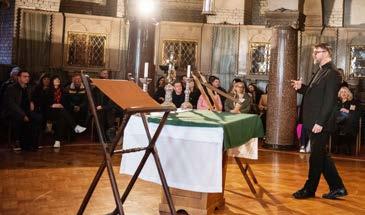
On Shrove Tuesday, we welcomed dozens of volunteers from American Express, Victoria, for an afternoon of cleaning and gardening. Many of the volunteers are remote workers from across the UK, who gathered together in London for a ‘Giving Back in the Community’ event. We are most grateful for their hard work.
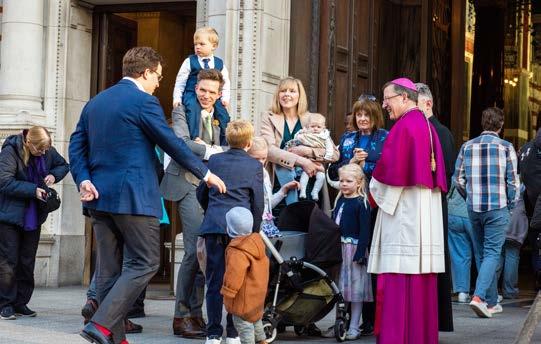
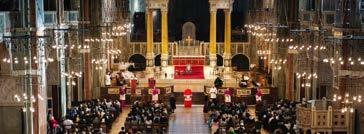
This year, we welcomed over 500 catechumens (Baptism) and candidates for Confirmation at the Rite of Election, the largest number since 2018. Deo gratias!
In addition to the Cathedral floor, the whole complex has been undergoing a series of maintenance and restoration work lately. The courtyard is now clear of scaffolding, the trees have been pollarded, the roof has been surveyed, and there has been a lighting upgrade in ‘Long Corridor’, the main thoroughfare beyond the Sacristy.
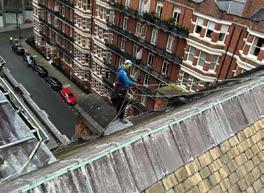
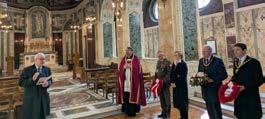
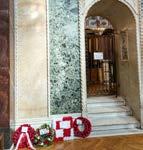
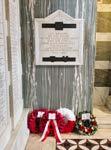
On 15 March, we were joined by the Lord Mayor of Westminster and the Polish Airmen’s Association, for an Act of Remembrance at the two Polish War Memorials. The first, dedicated to the Polish Airmen on 15 March 1944, above the Lady Chapel gate, and the second, more general memorial, was unveiled in St George’s Chapel 60 years ago by Cardinal Heenan, in February 1965.
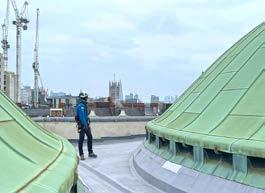
To coincide with the Jubilee of Volunteering, Caritas Westminster hosted a volunteering fair in Cathedral Hall, offering an opportunity to learn more about various organisations and opportunities.
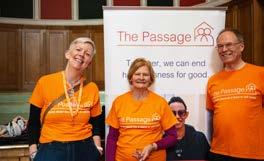
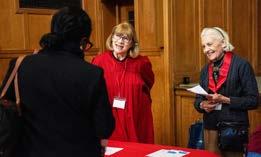

Ralph Fiennes is a great actor. At least in last autumn’s film, Conclave, in which he stars as the modest Cardinal Lawrence organising the election of a Pope. It’s an absorbing fast-moving thriller in which the intrigue and politicking among the cardinals (incidentally, in real life forbidden by Pope John Paul II’s ordinance) would make Machiavelli blush. Predictably perhaps, we also have the recurrent secular caricature of shallow ‘conservative’ versus open-to-learning ‘progressive’. But, notwithstanding the significant red flags I raise below, there doesn’t seem to be an anti-Catholic agenda at work here. Indeed, the film is based on an engaging novel by the successful historical thriller writer Robert Harris.
It has just won ‘Best Film’ at the BAFTAs down on the South Bank, and ‘Best Adapted Screenplay’ at the Academy Awards. At this time when we are praying earnestly for the Pope’s health, the next real-life conclave looms. This will give the film another boost. Indeed, it presents the processes accurately and with beautiful cinematography. Already numerous Catholics and non-Catholics have raised the movie in conversation with myself. However, from the point of view of Catholic belief, it has caused some confusion with a few subtle but significant flaws. The gripping quality of Ralph Fiennes’ acting and script paradoxically make the film’s failures to ‘get’ Catholicism more insidious. Highlighting them also illustrates the manner in which our slick secular culture can, often unwittingly, ‘evangelise’ us.
Cardinal Lawrence’s initial grief at the death of the previous Pope grabs the viewer. Fiennes’ depiction well draws the audience into empathising with his assiduous guiding of the handing on of the torch of St Peter, or rather the ‘Chair’. The psychological pressure upon him to do this faithfully and wisely builds engrossingly
through a series of intrigues and events. You can sense Lawrence’s angst that these might submerge that sacred Chair in human foible and worldly politics, and that he himself might even be a cause.
However, on three occasions this ‘wisdom’ is actually, from the point of view of Church teaching, unwise. Spoiler alert –though I’ll try to minimise!
Firstly, the film is top and tailed by two speeches to the assembled cardinals. Initially, Cardinal Lawrence offers what he senses is a much-needed warning to guard against personal motivations and party politics in their voting. But he generalises the point in a manner that undermines Catholic teaching.
With a conviction that could only be mustered by a grieving admirer of the previous occupant of the Chair of Peter, and respecter of the Chair itself, he carefully argues that ‘in the name of unity and tolerance… certainty is a sin.’ Faith must involve doubt. Our Lord Jesus showed this, he pleads, in uttering from the Cross ‘My God, My God, why hast thou forsaken me?’ (the beginning of Psalm 22). Towards the end of the film, another cardinal picks up on the theme in an influential speech.
The certainty with which they passionately proclaim the importance of not being certain manifests that contradiction present in our contemporary intolerant relativism. Further, Psalm 22, which is for sure in solidarity with those who doubt or despair, actually predicts Christ’s Passion closely and ends in the triumph and praise of God. As paragraph 157 of the Catholic Catechism states:
‘Faith is certain. It is more certain than all human knowledge because it is founded on the very word of God who cannot lie. To be sure, revealed truths can seem obscure to human reason and experience, but “the certainty that the
divine light gives is greater than that which the light of natural reason gives.”
[St Thomas Aquinas] “Ten thousand difficulties do not make one doubt.” [St John Henry Newman]’
Faith, in short, is a leap in the light, not a leap in the dark.
Secondly, Cardinal Lawrence, under great pressure as ever, gets some needed information from a nun by coaxing her to go to confession to him. Lawrence discreetly shares this information, which is negative about another cardinal, with that latter cardinal. This latter dutifully learns a lesson from it but pleads with Lawrence not to share the information publicly. Lawrence confirms that he couldn’t possibly do that given the seal of confession.
This a travesty of the seal which does not allow the priest, under pain of excommunication, to use information gained in confession in any way whatsoever.
Thirdly, one cardinal is revealed as having female internal reproductive organs, but male external ones. The previous Pope, we are informed, thought that that wouldn’t stop such a person rising in the priestly hierarchy. Our gallant Cardinal Lawrence, is surprised to hear that. After all, this intersex cardinal is fundamentally, that is in terms of basic procreative capacities, female, and priests must be male according to scripture, tradition and definitive teaching from the said Chair of Peter (which for Catholicism is of course Christ’s infallible ‘But I say to you’). But Lawrence then quickly agrees that such a cardinal can, after all, be made Pope.
You might not have noticed in this slick drama, but our ‘wise’, top cardinal, wellacted by Fiennes in a film perhaps destined to be a classic, directly undermines the Catholic faith – three times!
Andrew Hollingsworth
Following a series of hugely successful campaigns, the Friends have managed to secure the funding needed to upgrade the Cathedral lighting and restore the vast parquet floor, which is coming along nicely. This time, our urgent attention is needed to address the damp in Cathedral Hall, owing to the state of the leaded glass windows.
Originally called ‘Chapter Hall’, it was built in tandem with Westminster Cathedral, and completed in time for the regular celebration of Mass and the Divine Office from Ascension Day, May 1902. The Hall continued in this way until the Cathedral was officially opened at Midnight Mass on Christmas Eve 1903. The Hall, itself a listed building, has also been at the forefront of many historical events, including the Papal Visit of Pope St John Paul II.
Cathedral Hall continues to be a valuable resource for the parish, Diocese and the local community. In addition to the occasional Mass during a large event, and regular parish group meetings, it is also a much sought-after venue for musical societies and the Choir School. Indeed, both the Bach Choir and Chopin Society are regular fixtures, as is the NHS Blood Donation service. It hosts talks, receptions, private events, and even the occasional Friends’ Quiz Night.
This is not the first time the Friends have sought to upgrade the Hall. Many of you will remember the successful campaign to renovate the kitchen, and the huge difference that has made in creating a more convivial and welcoming environment.
With buildings of this age there are always maintenance issues that need addressing and, unfortunately, there are no shortcuts. The current issues are the leaded glass windows, some of which are leaking into the walls, causing damp and allowing

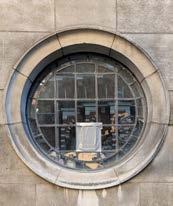
cold draughts to fill the Hall in winter. The only solution is to professionally remove, renovate, and reinstall each window. This should bring it back to the standard of the day, when the Hall was first opened to the public, for another 120 years.
With your help, we aim to raise an initial £40,000 by Easter. We are carrying out this campaign with Big Give, so in fact we appeal to your generosity to help us raise £20,000 online, which will be doubled to £40,000 by matched funding. With Gift Aid we could raise a figure closer to £50,000, which could cover the cost of repair of all the windows on the Ambrosden Avenue side of the building and the first very large round window facing into the car park. This is the first stage of our plan to restore the windows in the Hall. A further campaign will commence later in the year to complete the project.
Please do give generously to this important campaign, which opens on Monday 31 March at 12 noon. For every £100 donated, the Cathedral will receive an additional £100 in matched funding and a potential £25 in Gift Aid.
Finally, a very big thank you to everyone who has so generously supported our earlier Big Give campaigns. We are planning a Thank You party for benefactors in Cathedral Hall this summer. Full details in the next edition.
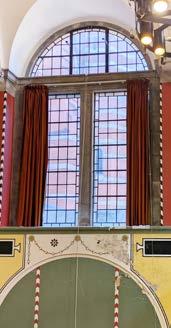
visit tinyurl.com/FriendsBGEaster25, or scan the QR code. Alternatively, email friends@rcdow.org.uk and we will be delighted to help.

Devotion to St Winefride, Blessed Edward Oldcorne SJ Born in Yorkshire, he made his studies in Rheims and Rome, where he remained six years, was ordained priest and admitted into the Society of Jesus. He came over to England with Father John Gerard SJ, in 1588 and was sent into Worcestershire, where he laboured with great zeal and profit. Under the stress of his labours and many dangers his health gave way, and he was reduced to extreme weakness by a violent hæmorrhage and an apparently incurable cancer in his mouth. He resolved to have recourse to St Winefride, and by bathing in her well was completely cured. He was seized at Henlip, and after being five times racked in London was executed at Worcester, 7 April 1606
Flemish engraving of Edward Oldcorne (1561–1606), English Jesuit priest.
The Holy Father’s Prayer Intentions
For the use of the new technologies
Let us pray that the use of the new technologies will not replace human relationships, will respect the dignity of the person, and will help us face the crises of our times.
Tuesday 1 April
Lent Feria
4.45pm Chapter Vespers, with Installation of a Canon
5.30pm Chapter Mass
Wednesday 2 April
Lent Feria
(St Francis of Paola, Hermit)
1.15pm Lunchtime Concert – Evan Lawrence (London Oratory)
Thursday 3 April
Lent Feria
2pm SVP School Passion Play
Friday 4 April Friday abstinence
Lent Feria
(St Isidore, Bishop & Doctor)
6.15pm Stations of the Cross
Saturday 5 April
Lent Feria
(St Vincent Ferrer, Priest)
2pm Mass for Bereaved Parents
4pm Low Mass (Blessed Sacrament Chapel)
Sunday 6 April Ps Week 1
5th SUNDAY OF LENT
12 noon Solemn Mass (Cantor)
4pm Vespers (English) and Benediction
4.30pm Mass for the Deaf Community (Cathedral Hall)
Monday 7 April
Lent Feria
(St John Baptist de la Salle, Priest)
The Cathedral is open from 7.30am and closes in time for 7pm.

Monday to Friday: Morning Prayer 7.35am, Mass 8am, Mass (Latin, unless there is a Funeral) 10.30am, Confessions 11.30-12.30pm, Mass 12.30pm *, Exposition of the Blessed Sacrament 1.15-4.30pm, Benediction 4.30pm, Confessions 4.30-5.30pm, Sung Vespers 5pm (Latin, Choir, except Tuesday, English, Cantor), Solemn Mass 5.30pm (Choir, Tuesday: Boys’ voices, Wednesday: Men’s voices)
Saturday: Mass 8am, Morning Prayer 10am, Mass 10.30am (Latin, Choir,) Confessions 11.30-12.30pm, Mass 12.30pm *, Confessions 5-6pm, Sung Vespers 5.30pm (English, Cantor), Sung Mass 6pm.
Sunday: Mass 8am, Sung Morning Prayer 9.30am, Sung Mass 10am, Confessions 10.30-12.30pm; Solemn Mass (Choir) 12noon *, Solemn Vespers (Choir) and Benediction 4pm, Confessions 5-6.45pm, Sung Mass 5.30pm, Mass 7pm.
For full opening and closure times of the Cathedral and for confession and service times please consult the Cathedral diary on the website.
* Live streamed via the Cathedral website
Tuesday 8 April
Lent Feria
Wednesday 9 April
Lent Feria
1.15pm Lunchtime Concert – Edward Byrne (Magdalen College, Oxford)
Thursday 10 April
Lent Feria
5.30pm The Friends of the Holy Father attend Mass (Papal Nuncio)
Friday 11 April Friday abstinence
Lent Feria
(St Stanislaus, Bishop and Martyr) 6.15pm Stations of the Cross
Saturday 12 April
Lent Feria
Sunday 13 April Ps Week 2
PALM SUNDAY OF THE PASSION OF THE LORD
11.30am Procession and Solemn Mass (Full Choir)
Ingrediente Domino – Malcolm Christus factus est – F. Anerio
Passion according to St. Luke – Victoria Mass for four voices – Byrd
Ne irascaris – Byrd
Civitas sancti tui – Byrd
4pm Solemn Vespers and Benediction Magnificat octavi toni – Victoria Improperium exspectavit – Lassus

Monday 14 April
MONDAY OF HOLY WEEK
Tuesday 15 April
TUESDAY OF HOLY WEEK
12 noon Solemn Pontifical Mass of Chrism (Full Choir)
Missa brevis Sancti Ioannis de Deo – Haydn
In spiritu humilitatis – Croce Ave verum corpus – Mawby
Organ: Con moto maestoso (Sonata III) –Mendelssohn
Wednesday 16 April
WEDNESDAY OF HOLY WEEK
1.15pm Lunchtime Concert – François Cloete (Merton College, Oxford)
Thursday 17 April
MAUNDY THURSDAY
6pm Solemn Evening Mass of the Lord’s Supper (Full Choir)
Mass for five voices – Byrd Hoc est præceptum meum – Guerrero Tristis est anima mea – Poulenc
Friday 18 April Fast and abstinence
GOOD FRIDAY
10am Office of Readings (Full Choir)
Tenebræ responsories – Victoria
Christus factus est – F. Anerio
3pm Solemn Liturgy of the Passion (Full Choir) Christus factus est – Bruckner
Passion according to St. John – Victoria
Improperia – Victoria
Crux fidelis – King John IV of Portugal
Tenebræ factæ sunt – Poulenc
Vinea mea electa – Poulenc
6.30pm Stations of the Cross
Saturday 19 April Fast as desired
HOLY SATURDAY
10am Office of Readings (Full Choir)
Tenebræ responsories – Victoria Christus factus est – F. Anerio
8.30pm The Easter Vigil in the Holy Night (Full Choir)
Iubilate Deo – Lassus
Exodus canticle – Reid
Sicut cervus – Palestrina
Messe – Widor
Surrexit pastor bonus – L’Héritier
Organ: Final (Symphonie VI) – Widor
Sunday 20 April
EASTER SUNDAY OF THE RESURRECTION OF THE LORD
12 noon Solemn Pontifical Mass (Full Choir)
Missa Papæ Marcelli – Palestrina
Dic nobis Maria – Bassano
Dum transisset Sabbatum – Taverner
Organ: Prelude and Fugue in B major – Dupré 4pm Solemn Vespers and Benediction (Men’s voices)
Magnificat primi toni – Palestrina
Surrexit pastor bonus – Palestrina
Organ: Final (Symphonie I) – Vierne
Monday 21 to Friday 25 April
The Cathedral opens at 9.30am and closes at 6pm;
10am Morning Prayer
10.30am Mass
11.30am – 12.30pm Confessions
12.30pm Mass
5pm Evening Prayer
5.30pm Mass
Monday 21 April
MONDAY WITHIN THE OCTAVE OF EASTER
Tuesday 22 April
TUESDAY WITHIN THE OCTAVE OF EASTER
Wednesday 23 April
WEDNESDAY WITHIN THE OCTAVE OF EASTER
Thursday 24 April
THURSDAY WITHIN THE OCTAVE OF EASTER
Friday 25 April No Friday abstinence
FRIDAY WITHIN THE OCTAVE OF EASTER
Saturday 26 April
SATURDAY WITHIN THE OCTAVE OF EASTER
Usual timetable resumes
Sunday 27 April
2nd SUNDAY OF EASTER
(or of Divine Mercy)
12 noon Solemn Mass (Cantor) 4pm Vespers (English) and Benediction
Monday 28 April
St GEORGE, Martyr, Patron of England (National)
Tuesday 29 April
St CATHERINE OF SIENA, Virgin & Doctor, Patroness of Europe (National)
Wednesday 30 April
Easter Feria
(St Pius V, Pope)
Choral services resume on Thursday 1 May.
Key to the Diary: Saints’ days and holy days written in BOLD CAPITAL LETTERS denote Sundays and Solemnities, CAPITAL LETTERS denote Feasts, and those not in capitals denote Memorials, whether optional or otherwise. Memorials in brackets are not celebrated liturgically.
Catholic Evidence Guild
Clergy House Room 2, Tuesdays 7pm Catholic Grandparents’ Association Hinsley Room, Second Sundays 12-3.30pm
Charismatic Prayer Group
Cathedral Hall, Fridays 6.30-9pm
Divine Mercy Prayer Group
St Patrick’s Chapel, Sundays 1.30-2.30pm
Filipino Club Cathedral Hall, Second Sunday 1-5pm
Guild of the Blessed Sacrament Blessed Sacrament Chapel, Mondays 6.15pm
Guild of St Anthony Lady Chapel, Tuesdays 6.15pm
Interfaith Group Hinsley Room, Third Wednesdays 1.30 -3pm
Legion of Mary Hinsley Room, Monday 1.30-3.30pm
Nigerian Catholic Association Hinsley Room, Fourth Sundays 1.30-2.30pm
Oblates of Westminster Cathedral Hinsley Room, Fourth Sundays 2.30-4pm
Padre Pio Prayer Group
Sacred Heart Church, First Thursdays 1.30-3.30pm
Rosary Group
Lady Chapel, Saturdays 11.15-12.00noon
Walsingham Prayer Group
St George’s Chapel, First Tuesdays 2.30-4pm
Yoruba Association Hinsley Room, Third Sundays 1.30-3pm
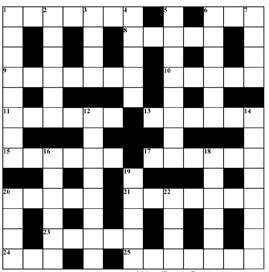
1 Tenth parts of a Roman Legion (7)
6 ‘--- transit gloria mundi’, ‘thus pass the glories of the world’ (3)
8 Gustav, composer of ‘St.Paul’s Suite’, named after Girls’ School in Hammersmith (5)
9 An artist’s studio (7)
10 Italian city associated the Holy Shroud (5)
11 Grand Old Duke, had 10,000 men! (2,4)
13 Hang on a minute! (3,3)
15 Area of SW London in Wandsworth Borough (6)
17 River in Brazil, with a lot of packages? (6)
20 The colour red in heraldry (5)
21 When no word uttered (7)
23 As the Thames is, affecting its water level periodically (5)
24 Tree associated with Lent? (3)
25 Biblical city of ancient Egypt and modern US city of blues music (7)
Clues Down
1 Burial place of an early Christian (8)
2 Belief contrary to orthodox religious teaching (6)
3 Guido, [d.1642], prodigious Italian painter of religious works (4)
4 Coastline with ditch near Whitechapel! (5)
5 Where to board train on which to make political speech? (8)
6 Level of a building, with a tale to tell? (6)
7 Bluey-green colour (4)
12 Gershwin composed one ‘In Blue’ (8)
14 Decade (3,5)
16 Demonic woman of mythology, in which is a claim she was Adam’s first wife (6)
18 Highest point (6)
19 One of 150 in Book of the OT (5)
20 Sensitive area in Middle-East where Samson was blinded (4)
22 An ominous textile tool (4)
by GK Chesterton
When fishes flew and forests walked, And figs grew upon thorn, Some moment when the moon was blood, Then surely I was born.
With monstrous head and sickening cry, And ears like errant wings, The devil’s walking parody Of all four-footed things.
The tattered outlaw of the earth, Of ancient, crooked will; Starve, scourge, deride me: I am dumb, I keep my secret still.
Fools! For I also had my hour; One far fierce hours and sweet: There was a shout about my ears, And palms before my feet.
.....
by Gerard Manley Hopkins
Nothing is so beautiful as Spring –When weeds, in wheels, shoot long and lovely and lush; Thrush’s eggs look little low heavens, and thrush Through the echoing timber does so rinse and wring The ear, it strikes like lightnings to hear him sing; The glassy peartree leaves and blooms, they brush The descending blue; that blue is all in a rush With richness; the racing lambs too have fair their fling.
What is all this juice and all this joy?
A strain of the earth’s sweet being in the beginning In Eden garden. – Have, get, before it cloy, Before it cloud, Christ, lord, and sour with sinning, Innocent mind and Mayday in girl and boy, Most, O maid’s child, thy choice and worthy the winning.
To submit a poem whether by yourself or another for consideration, please contact the Editor – details on page 3.
Easter is celebrated on the first Sunday after the first full moon, following the spring equinox. It is the most important feast in the Christian year, commemorating Jesus’ Resurrection and his victory over death.
After the third day of his crucifixion, the Gospel of Luke (24:6-7) says:
‘He is not here; he has risen! Remember how he told you, while he was still with you in Galilee: “The Son of Man must be delivered over to the hands of sinners, be crucified and on the third day be raised again.”’
Another important thing is the empty tomb. In the same way, the empty tomb is a symbol of the Resurrection. As Luke 24:2-4 says:
‘and they found the stone rolled away from the tomb, but when they entered, they did not find the body of the Lord Jesus.’
Easter is also a time which symbolises renewal, both spiritually and in nature, as it coincides with the arrival of spring. Eggs, lamb, and flowers (especially lilies) are all associated with Easter, representing new life.
Many churches like Westminster Cathedral hold special services to celebrate the Resurrection, often starting in darkness and ending in light. This Mass is called the Easter Vigil. The Easter Vigil begins between sunset on Holy Saturday and sunrise on Easter Sunday. The Easter Vigil is the greatest and most holy of all solemnities in the Catholic Church.
On this holy night, the Church keeps watch, celebrating the Resurrection of Christ in the Sacraments and awaiting his return in glory. It is the turning point of the Sacred Paschal Triduum, the Passover of the New Covenant, which marks Christ’s passage from death to life. Therefore, the Easter Vigil does not correspond to the usual Saturday evening Mass, and its character is unique in the cycle of the liturgical year.
Traditions include Easter egg hunts, processions, and feasts, reflecting the joy of the Resurrection. Easter is different in many countries. In Poland they have water fighting, in Sweden they dress up as Easter witches, in Australia they make Easter Bilby, in the Philippines they read and chant a poem called ‘Pasyong Mahal’, which illustrates the life, Passion, death, and Resurrection of Jesus Christ. In the heart of Filipino Catholic tradition, Salubong remains one of the most profound and moving celebrations of the Easter season; there are many more celebrations during Easter in other countries.
At St Vincent de Paul we learn about Jesus Christ and what good deeds he has done for us, and we also do a Passion play at Westminster Cathedral.
The deeper meaning of Easter is how Jesus died on the cross and rose from the dead, promising us eternal life.

